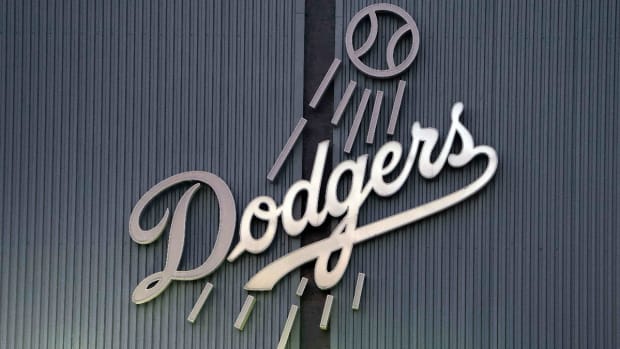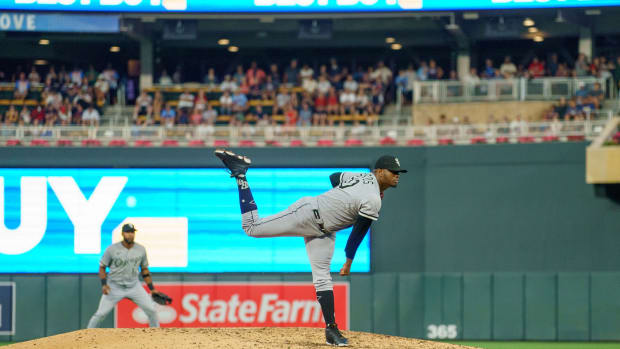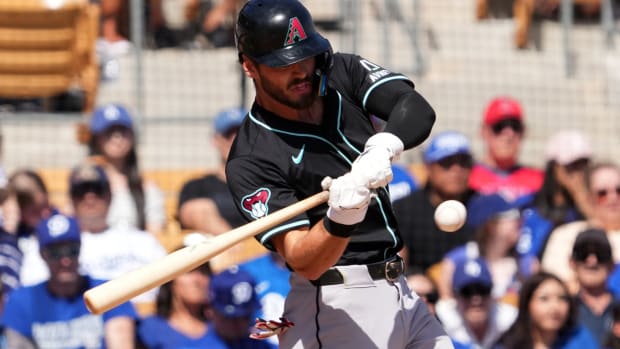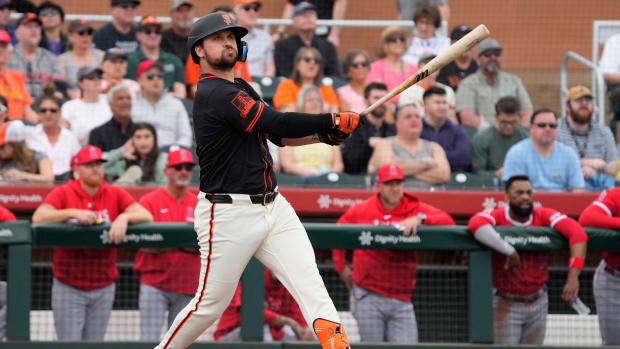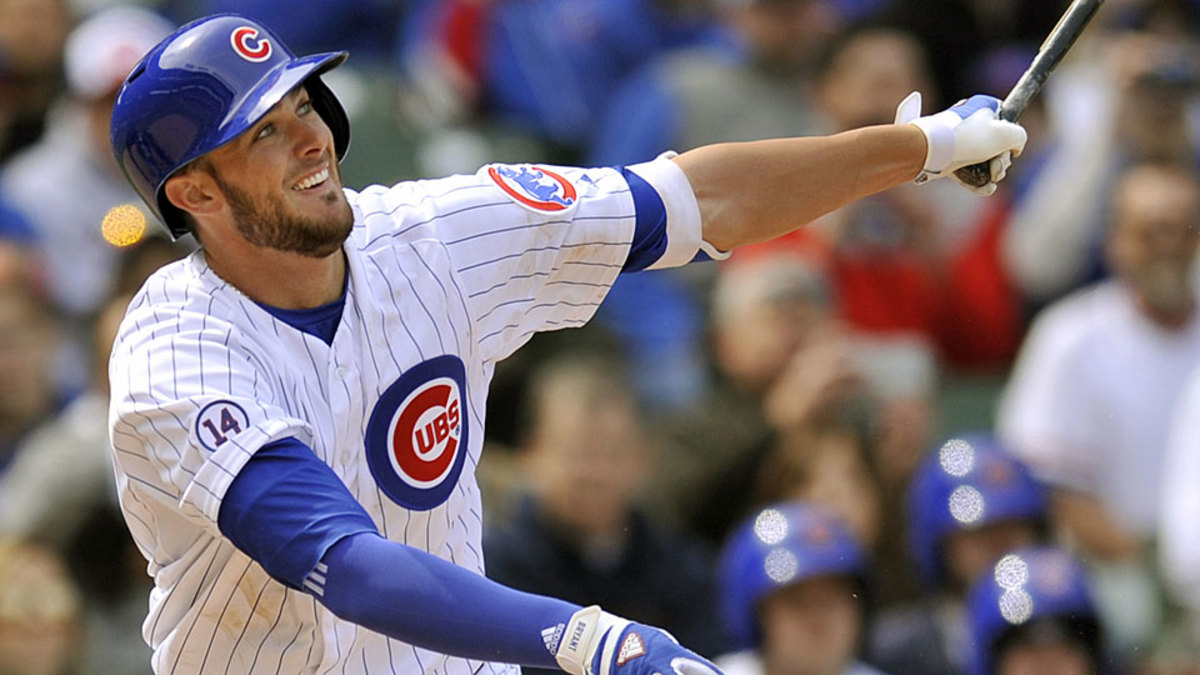
David Ortiz on Cubs' Kris Bryant and why hitting is harder than ever
David Ortiz heard the hype about Kris Bryant, watched him make his major league debut April 17 in which the Cubs made the rare move of shoving a young player with no experience into the cleanup spot, considered how pitching has become better than at any point in his 19-year career and arrived at one hard-hitting conclusion.
"It’s not fair to the kid,” said Ortiz, the Red Sox' 39-year-old designated hitter. “Bro, I’ll tell you, I saw him in spring training and he’s a monster. [But] I don’t think it’s fair to bring him up under those expectations, because bro, you don’t get away with [anything]."
I reminded him that the Nationals' Bryce Harper came up with huge expectations in 2012.
"No, not even close,” Ortiz said. "They brought Harper in with less expectations. There was an argument about bringing [Bryant] up. Today what pitchers do is they see that and they throw their best [to Bryant]. Spring training is not major league pitching. When a veteran guy pitches in spring training what they try to do is get comfortable with their [stuff]. In the season, they’re going to make you uncomfortable with their [stuff].
"I’m not saying he’s not a good player. I’m saying I don’t think it’s fair for him to be put in this situation. He’s going to see the best [stuff] of every [guy] he faces."
Ortiz is one of the smartest hitters in baseball. He watched on television as Padres ace James Shields worked over Bryant in his debut “the way he would pitch me.” Bryant struck out all three times he faced Shields, and also grounded into a double play in the Cubs' 5–4 loss.
• TAYLER: Loss of McCarthy leaves Dodgers scrambling for pitchers
How rare was it for a player to bat cleanup in his major league debut? This rare: Bryant, 23, is the first player since Justin Morneau of the 2003 Twins to debut in the cleanup spot before his 24th birthday—and only the 34th player to do so since 1914, according to baseball-reference.com. (Only one of those kid cleanup hitters wound up in the Hall of Fame: Kiki Cuyler of the 1921 Pirates.)
Bryant appears to be an anomaly in today’s games: a plug-and-play cleanup hitter who can hit, as Ortiz might say, the best [stuff] on the planet. O.K., so the guy who hit 43 homers in the minors last year hasn’t hit a home run yet in the big leagues. But after 10 games with Chicago, Bryant has a ridiculous slash line of .351/.478/.459 and looks like the kind of impact hitter who can make the difference between the Cubs being a cute little "we’re-one-year-away" club to an honest-to-goodness postseason contender.
After Adam Wainwright's injury, what's next for Cardinals, DH rule?
What’s so impressive is the way Bryant, a righthanded hitter, is grinding out at-bats for such a young hitter. He is seeing 4.33 pitches per plate appearance, which, had he enough plate appearances to qualify, would rank him fourth in the NL behind only the Mets' Lucas Duda, Harper and the Padres' Alexi Amarista, all lefthanded hitters. (The top 11 in the league are all lefthanded.)
Nobody walks into the major leagues at Bryant's age and hits like this—not with the way pitching is today. Over the previous two seasons, 464 batters made their major league debut. Only one was as young as Bryant and even qualified for the batting title in his debut season: Nolan Arenado of Colorado, whose slash line in his rookie season of 2013 was more believable (.267/.301/.405). Bryant may be the rare hitting prodigy in a pitching-dominant game.
• JAFFE: Texas offers Hamilton chance to rebuild life and career
"He’s going to hit," Ortiz said. "I just don’t think it’s fair to a young player because I’m going to tell you what, the pitching at this level right now, it’s a [bear]. Bro, pitching right now is so powerful. Put it this way: When I first got to the big leagues, I knew a guy who had a good fastball was 95–96 [mph] and he might have one off-speed pitch he will use to strike you out, but you’re going to see the fastball.
"Now, the guy who throws 100 also throws slider, change and breaking ball. You don’t know which one of those is coming. And everybody has flamethrowers in the bullpen. And the location right now in the big leagues is ridiculous.
"The pitching right now, I’d say last year was the best I saw my whole career. When you went over scouting reports before you would say, ‘Oh, I got this guy. And I got this guy they’re going to bring in from the bullpen.’ The sinker-slider guy who throws 88 to 90? That pitcher is not in the game anymore. Every lefthander coming out of the bullpen is throwing the hardest slider and 95 plus.
"I was looking at the game 30 years ago or something, and it’s not even close to what it is now. How many lefthanded relievers throwing 95 plus did Ted Williams face? I spent two games seeing nothing but lefties, different angles. If I see a starter three times it’s only because he’s dealing, because he’s on. It was what it was back then, but the game right now is a [bear]. The pitching last year was the best pitching I’ve ever seen and this year I’m pretty sure it’s the same thing or even better."
• POWER RANKINGS: Cardinals jump over Tigers, Mets for first place
Ortiz has faced a starting pitcher for the third time in a game only 12 times this year. Because of bullpen depth and velocity, the most important decision for the modern manager is whether to stick with his starting pitcher when the lineup turns over for a third time. Increasingly, the answer is to turn the game over to the bullpen.
Check this out: the percentage of plate appearances that came against a starting pitcher for a third time or more in the same game, as shown in five-year increments:
1985: 22.5%
1990: 21.1%
1995: 20.2%
2000: 20.4%
2005: 20.2%
2010: 19.7%
2015: 16.9%
The trend is obvious. The times when hitters get to see a fatiguing starting pitcher are becoming more rare.
Why is this trend accelerating? The choice for a manager—would you rather have your starter face the lineup a third time or bring in a fresh arm?—has become more obvious. Here's something else to check out: the difference in batting average between a starter facing a lineup for a third time and a reliever facing it for the first time, shown in the same five-year increments:
Years | SP 3rd Time | RP 1st Time | Difference |
1985 | .265 | .251 | -.014 |
1990 | .266 | .251 | -.015 |
1995 | .277 | .260 | -.017 |
2000 | .284 | .263 | -.021 |
2005 | .279 | .256 | -.023 |
2010 | .272 | .249 | -.023 |
2015 | .266 | .227 | -.039 |
Look how the gap has grown. Starters lose their stuff essentially at the same rate as they did 30 years ago, but batters now hit just .227 when they see a reliever for the first time! That’s crazy.
"The game has changed, and it’s not just velocity," Nationals pitcher Max Scherzer said. "It used to be that as a starting pitcher you wanted to have three pitches. Now it’s four—with command. It used to be that a relief pitcher needed only one really good pitch and one so-so pitch. Now you see more guys coming out of the bullpen establishing three pitches. And now that guy can get out righthanders and lefthanders. The cutter is just one pitch that you see more, but no matter what the pitch is, the trend is pitchers are adding pitches, whether they’re starters or relievers."
How many home runs would A-Rod have if he had stayed healthy, clean?
Said Ortiz, “I’m telling you, bro, pitching is a [bear]. They’re paying $100 million to a guy who can hit .270 and get 70-80 RBIs consistently. He’s a hundred million dollar guy. Why do you think they’re getting that? Pitching. The guy who hits 30, 40 home runs is going to make Miguel Cabrera money.
"What I saw last year, I’m telling you, I faced guys that I was like, ‘Oh, my God.’ You don’t say that out loud because you don’t want people to think you’re giving up or checking out, but I faced some [bears]."
This is the game into which Bryant walks. It is a pitching dominant game in which hitters face more velocity, more pitches and more fresh arms than ever before. And yet even without displaying his best skill—raw home run power—Bryant has made the jump from Triple A into the cleanup spot in the Chicago lineup look easy. Maybe the real [bear] here is Bryant.






























